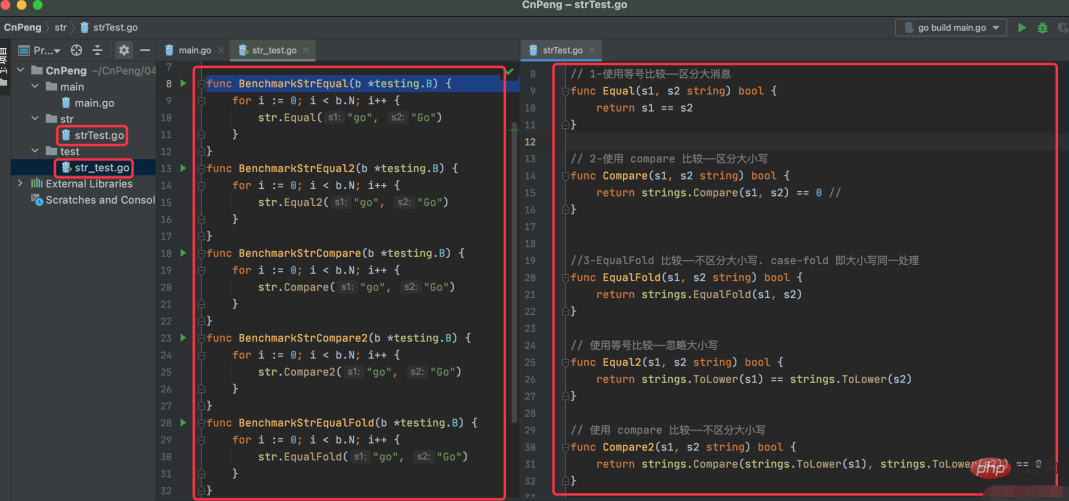比较方法:1、直接使用“==”运算符比较,语法“str1 == str2”,该方法区分大小写。2、利用strings包的Compare()函数比较,语法“strings.Compare(a,b)”;返回值为int类型,0表示两数相等,1表示a大于b,“-1”表示a小于b。3、利用strings包的EqualFold()比较,语法“strings.EqualFold(a,b)”。

本教程操作环境:windows7系统、GO 1.18版本、Dell G3电脑。
Go语言比较字符串方式
在 go 语言中字符串比较的方式有如下三种:
==直接比较,区分大小写strings.Compare(a,b)该函数返回值为 int, 0 表示两数相等,1 表示 a>b, -1 表示 a<b。区分大小写strings.EqualFold(a,b)直接返回是否相等,不区分大小写。
示例如下:// 1-使用等号比较——区分大消息
func Equal(s1, s2 string) bool { return s1 == s2 } // 2-使用 compare 比较——区分大小写 func Compare(s1, s2 string) bool { return strings.Compare(s1, s2) == 0 // } //3-EqualFold 比较——不区分大小写. case-fold 即大小写同一处理 func EqualFold(s1, s2 string) bool { return strings.EqualFold(s1, s2) } // 使用等号比较——忽略大小写 func Equal2(s1, s2 string) bool { return strings.ToLower(s1) == strings.ToLower(s2) } // 使用 compare 比较——不区分大小写 func Compare2(s1, s2 string) bool { return strings.Compare(strings.ToLower(s1), strings.ToLower(s2)) == 0 } func StringCompareTest() { fmt.Println("== 区分大小写", Equal("go", "Go")) //false fmt.Println("== 忽略大小写",Equal2("go", "Go")) //true fmt.Println("compare 区分大小写",Compare("go", "Go")) //false fmt.Println("compare 忽略大小写",Compare2("go", "Go")) //true fmt.Println("EqualFold 忽略大小写",EqualFold("go", "Go")) // true }
登录后复制
性能比较
下面的代码使用 Benchmark 做简单的性能比较,测试项目的目录结构为:

详细代码:
package test import ( "../str" "testing" ) func BenchmarkStrEqual(b *testing.B) { for i := 0; i < b.N; i++ { str.Equal("go", "Go") } } func BenchmarkStrEqual2(b *testing.B) { for i := 0; i < b.N; i++ { str.Equal2("go", "Go") } } func BenchmarkStrCompare(b *testing.B) { for i := 0; i < b.N; i++ { str.Compare("go", "Go") } } func BenchmarkStrCompare2(b *testing.B) { for i := 0; i < b.N; i++ { str.Compare2("go", "Go") } } func BenchmarkStrEqualFold(b *testing.B) { for i := 0; i < b.N; i++ { str.EqualFold("go", "Go") } }
登录后复制
测试结果如下:

通过上图可以看出,效率最高的还是 ==
源码简单分析
1、strings.Compare
package strings // Compare returns an integer comparing two strings lexicographically. // The result will be 0 if a==b, -1 if a < b, and +1 if a > b. // // Compare is included only for symmetry with package bytes. // It is usually clearer and always faster to use the built-in // string comparison operators ==, <, >, and so on. func Compare(a, b string) int { // NOTE(rsc): This function does NOT call the runtime cmpstring function, // because we do not want to provide any performance justification for // using strings.Compare. Basically no one should use strings.Compare. // As the comment above says, it is here only for symmetry with package bytes. // If performance is important, the compiler should be changed to recognize // the pattern so that all code doing three-way comparisons, not just code // using strings.Compare, can benefit. if a == b { return 0 } if a < b { return -1 } return +1 }
登录后复制
如上所示,我们发现,Compare 内部也是调用了 == , 而且该函数的注释中也说了,这个函数 only for symmetry with package bytes。而且推荐我们直接使用 == 和 >、<。
2、strings.EqualFold
// EqualFold reports whether s and t, interpreted as UTF-8 strings, // are equal under Unicode case-folding, which is a more general // form of case-insensitivity. func EqualFold(s, t string) bool { for s != "" && t != "" { // Extract first rune from each string. var sr, tr rune if s[0] < utf8.RuneSelf { sr, s = rune(s[0]), s[1:] } else { r, size := utf8.DecodeRuneInString(s) sr, s = r, s[size:] } if t[0] < utf8.RuneSelf { tr, t = rune(t[0]), t[1:] } else { r, size := utf8.DecodeRuneInString(t) tr, t = r, t[size:] } // If they match, keep going; if not, return false. // Easy case. if tr == sr { continue } // Make sr < tr to simplify what follows. if tr < sr { tr, sr = sr, tr } // Fast check for ASCII. if tr < utf8.RuneSelf { // ASCII only, sr/tr must be upper/lower case if 'A' <= sr && sr <= 'Z' && tr == sr+'a'-'A' { continue } return false } // General case. SimpleFold(x) returns the next equivalent rune > x // or wraps around to smaller values. r := unicode.SimpleFold(sr) for r != sr && r < tr { r = unicode.SimpleFold(r) } if r == tr { continue } return false } // One string is empty. Are both? return s == t }
登录后复制
这个函数中做了一系列操作,将两个字符串转换成 utf-8 字符串进行比较,并且比较时忽略大小写。
总结
通过上面的简单总结和分析,我们发现,字符串比较还是直接用 == 、>、 < 比较运算符吧,简单快捷效率高。
【
 站长资讯网
站长资讯网